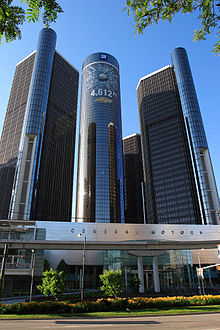Renaissance Center
The Renaissance Center, commonly known as the RenCen,[8] is a complex of seven connected skyscrapers in downtown Detroit, Michigan, United States.
[9][10] Developed as an urban renewal project in the 1970s, the Renaissance Center was envisioned as a "city-within-a-city," and was meant to anchor a wider redevelopment of the then-declining city of Detroit.
The project was developed and funded by a consortium led by the Ford Motor Company, and John Portman served as its principal architect.
An extensive renovation, completed in 2004, significantly altered its Brutalist interior, improved access to the center from downtown, and added a new glass retail atrium and public plaza on the riverfront.
[8][14] With 5,552,000 square feet (515,800 m2) of usable space, it is one of the world's largest commercial complexes, and the central tower has been the tallest building in Michigan since its completion in 1977.
[5][15] At the time of its completion, the Renaissance Center was the largest private development in the history of the United States,[16] and the central tower was the world's tallest hotel.
[17] In recent years, the massive center has struggled with declining occupancy, particularly stemming from increased remote work amidst the COVID-19 pandemic.
[18][19] General Motors has announced plans to relocate its headquarters away from the Renaissance Center in 2025, leaving the future of the complex uncertain.
This was a private non-profit development organization which Ford headed in order to stimulate building activity and revitalize the economy of Detroit.
[9] The shopping center in the podium originally housed high-end boutiques, but now contains a greater complement of restaurants in the retail mix.
It became the world's tallest all-hotel skyscraper[17] surpassing its architectural twin, the Westin Peachtree Plaza Hotel in Atlanta.
[17][24] On April 15, 1977, Henry Ford II and Detroit mayor Coleman Young unveiled a plaque commemorating the private investors whose funds made the project possible.
During the 1980 Republican National Convention, hosted at nearby Joe Louis Arena, presidential nominee Ronald Reagan and former President Gerald Ford both stayed at the Renaissance Center.
Designed by Skidmore, Owings & Merrill, it rises 103 feet (31 m) tall at its highest point opening direct access to the International Riverfront.
[11] Together, GM's renovation of the Renaissance Center and the Detroit Riverwalk exceeded $1 billion; the project constituted a substantial investment in downtown.
[29] Nearly 2,000 state workers now occupy GM's former office building, the restored Cadillac Place, in the historic New Center district.
The renovation includes a lighted glass walkway which encircles the interior mezzanine for ease of navigation, while the addition of the winter garden provides riverfront access and a view of Canada.
A covered skyway over Jefferson Avenue connects to the Millender Center, Courtyard by Marriott - Downtown Detroit, and Coleman A.
[34] In 2011, the Detroit Wayne County Port Authority opened its new state of the art cruise ship dock and passenger terminal on Hart Plaza, adjacent to the Renaissance Center.
The animated logo and illuminated LED color bands around the towers can be used to support special events and may be seen from Comerica Park, home of the Detroit Tigers.
The renovation of TCF Center convention and exhibit facility incorporates similar blue neon lighting along riverfront promenade.
In January 2015, General Motors announced its intent to renovate much of the complex to make it more inviting as a destination for visitors to Detroit.
A photo-journalistic advertising campaign launched to "shine a spotlight on the people in Detroit who make remarkable contributions" to the city.
The rooftop restaurant (which previously had revolved) received a $10 million renovation and was operated by The Epicurean Groups's Coach Insignia (closed in 2017[39]).
[9] Detroit Renaissance continued to interact with the city, by contributing to a variety of projects within the downtown area in the ensuing decades.
[14][47][48] The companies' demand for taxpayer funding of the project was met with public opposition by many state lawmakers, including Matt Hall, the speaker-elect of the Michigan House of Representatives.
[14] In response, General Motors later stated that if lawmakers did not provide taxpayer funding, they would demolish the entire RenCen at their own expense, a proposal described by the Detroit Free Press as "likely... the largest voluntary skyscraper demolition in world history.
The Renaissance Center's modernist architecture balances the city's panoramic waterfront skyline, a frequent feature in photography taken from Windsor, Ontario,[22] across the river.
[29] A lighted glass walkway radiates the mezzanine level and encircles the base of cylindrical hotel tower for ease of navigation.
[15] The design is consistent with the themes of Brutalist architecture, especially in the heavy massing of concrete on the lower floors, but the 2001 renovation has softened those features.









